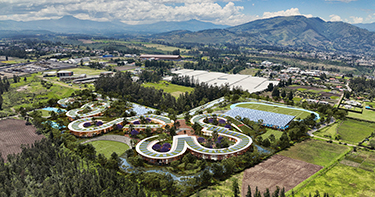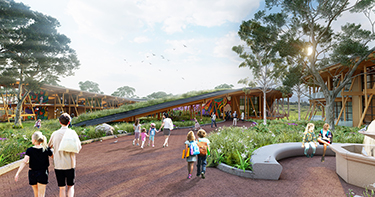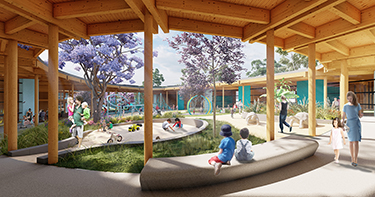|
Subscribe / Renew |
|
|
Contact Us |
|
| ► Subscribe to our Free Weekly Newsletter | |
| home | Welcome, sign in or click here to subscribe. | login |
Architecture & Engineering
| |
April 17, 2024
Miller Hull places 3rd in international school design competition
A/E Editor
A butterfly garden in a learning courtyard; a wetland that doubles as an outside classroom; and a series of meandering net-zero buildings. These are key elements of The Miller Hull Partnership's conceptual design for a new campus for the American School of Quito in Ecuador.
The Seattle-based firm recently took third place in an international design competition to find an architect for the new campus, which will be built on an undeveloped site, partially covered by wetlands.
The competition wrapped in March. It was organized by the school in association with the College of Architects of Pichincha.
The American School of Quito is a private institution founded in 1940. It currently serves over 2,000 children from the ages of 3 through the end of high school in three separate programs: the International Baccalaureate Primary Years Program, the Middle Years Program, and the Diploma Program.
Architects from all over the world were invited to enter the competition but did have to include a local architect in their team. Miller Hull's team included Quito-based firm Leppanen Anker Arquitectura. Other team members were U.S. firms Knot Studio, PAE Engineers, and Biohabitats.
Design teams were tasked with the relocation of the school from its current home in the city center of Quito to a developing neighborhood at the edge of the city. The design brief asked for a learning environment that could support up to 2,500 students and reflect the school's commitment to foster “freedom, responsibility, and democracy” while remaining committed “to the wellbeing of society and the environment.”
More than 100 teams entered the competition. Entries were subsequently narrowed down to 16 finalists. The finalists were then interviewed, and eight teams were invited to participate in the second and final phase of the design competition, which involved a site visit earlier this year.
POSSIBILITIES OF SUSTAINABLE K-12 DESIGN
I recently spoke with Brian Court, partner at Miller Hull, and Mathew Albores, principal at Miller Hull, who worked on the design.
The duo said the firm had been tracking the project for several years and was encouraged to enter the competition in part because of the school's commitment to making sustainability a central feature of its new campus.
The competition subsequently provided an excellent opportunity to explore the possibilities of sustainable K-12 school design, especially given the temperate climate in Quito.
This was a great fit for Miller Hull, which has been pushing the boundaries of sustainable architecture for decades and is the architect behind several net-zero and Living Future Certified buildings in Washington. That list includes the Bullitt Center, which when completed in 2013 was described by the International Living Future Institute as “the world's greenest commercial building.”
Miller Hull's architects have also been setting benchmarks when it comes to the design of sustainable educational facilities. Work in this market includes the Kendeda Building for Innovative Sustainable Design, which opened at Georgia Tech's campus in Atlanta in 2019.
That regenerative building creates more resources than it uses and was designed to showcase the possibilities of sustainable and regenerative design; the possible synergies between environmental stewardship and economic development; and to foster environmental education and research.
Miller Hull heard through the grapevine that the Kendeda Building was actually an inspiration for the American School's design brief, particularly its focus on sustainability.
Albores said the competition was an opportunity for the firm to build on the work it had already been doing in the realm of educational architecture, and to further explore how sustainable buildings can be employed as teaching tools to inspire the next generation of environmentalists and climate science leaders.
“We were really drawn to the overlap of education and sustainability in the competition brief,” Court confirmed. “We wanted to design a campus that would both house and support the school's current programs while also being a learning tool in-and-of itself that could teach the students about the campus environment and sustainable design,” he continued.
A NEW KIND OF CAMPUS
This vision is certainly played out in the design proposal, which the team says, “draws from the rich natural environments of Ecuador to develop a regenerative campus focused on the integration of the institution's established pedagogy with natural ecosystems.”
The imagined campus takes the form of a series of curvilinear courtyard buildings, with either two or two-and-a-half stories, that create smaller learning communities for each school program within the larger campus.
Each of the school's three programs would have its own building.
While the campus is unified by a common architectural language, each program/school building is designed to have a distinctive identity with its own compatible but specific color and materials palette, informed by developmental milestones and inspired by the different eco-regions of Ecuador.
A literal and figurative learning path would thread the campus community and buildings together, providing space for exploration, curiosity, and overlap between age groups.
While unique, Miller Hull's design also includes all necessary program spaces for a school of this size including libraries, a gymnasium, auditoriums, and cafeterias. The design is also fully ADA accessible.
Educational spaces overlap with the surrounding environment at many points including in outdoor classrooms, sensory gardens, and playgrounds to challenge the idea that learning only occurs in the classroom.
Each building would also double as a learning tool to teach students about regenerative design and has several innovative energy-saving features.
The entire campus design targets full Living Building certification and aims to be net-positive energy, net-zero water, and net-zero waste.
Net-positive energy would be targeted through rooftop PV arrays that Miller Hull estimates would provide enough energy not only to support the buildings but also to convert the school's existing diesel school buses to an electrified bus fleet.
Net-zero water and waste would be supported by newly constructed wetlands, bioswales, and a living machine that would process all stormwater and wastewater on site, avoiding additional loads to the municipal infrastructure.
“Each building on the campus is like a tree. It would get everything it needs to function from the site,” Court explained.
All structures are designed with healthy materials and would be primarily constructed of either wood or mass timber to further offset the campus's embodied carbon and help the new school blend in with the surrounding nature.
A MODEL FOR THE FUTURE
While the team's design proposal didn't win, Court and Albores are hopeful that the design might inspire other K-12 institutions who might be looking to redevelop their campus in an environmentally conscious way and believe it has the potential to become a model for sustainable campus planning in Quito and elsewhere.
“Sometimes I think people hear that a building is sustainable and think that means some kind of compromise had to be made when it comes to the look and experience of being inside the structure; that you somehow get less of a building,” Court reflected. “Our design for the American School in Quito proves this isn't the case,” he concluded.
The competition's winning team comprised Endara Arquitectos (Ecuador), Architekten (Ecuador), AHH Arquitectura (Netherlands), and Virai Arquitectos (Spain).
The new campus is expected to break ground within the next two years.
Emma Hinchliffe can be
reached by email or by phone
at (206) 622-8272.





